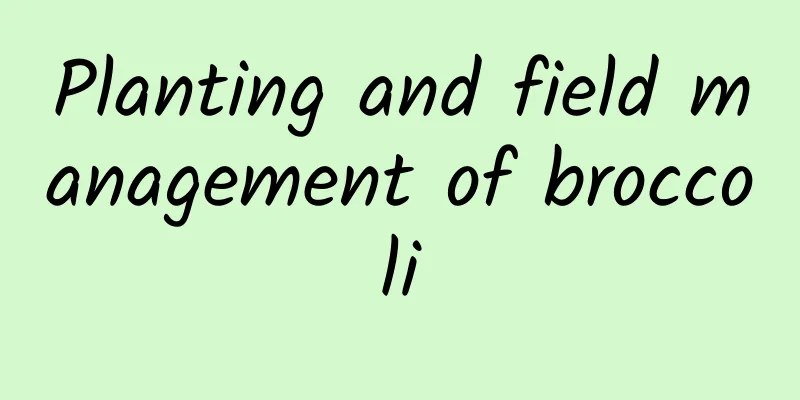Planting and field management of broccoli

|
Broccoli is also known as broccoli. Here is an introduction to the field management of broccoli: Biological habitsBroccoli is suitable for growing in cool climates. It can only be cultivated in autumn and winter in coastal areas of the province. In recent years, our county has made full use of the climate advantages of high altitude in mountainous areas, low summer temperature and large temperature difference between day and night, and carried out summer sowing and off-season cultivation on a large scale in high-altitude towns (950-1200m) such as Chishui and Guiyang. Generally, 10,000-12,000 kg of products can be harvested per hm2, which is exported to Japan and other countries with high economic benefits. In addition, its growth period is short (harvesting ends 60-70 days after transplanting), which is conducive to the development of multiple-ripening cultivation. 1. Planting.The summer sowing seedlings are 30-35 days old. Transplant with soil when they have 5-6 leaves. The spacing between rows and plants is 50 cm × 60 cm. Water them after planting to help the seedlings to grow well. 2. Top dressing.① Before buds appear, use quick-acting fertilizers as the main fertilizer. 7-10 days after planting, use 200 times of compound fertilizer or 10 times of decomposed human feces and urine to promote seedlings, and apply 2 kg of urea per mu at the same time; 14 days later, apply 15 kg of urea per mu. ② When buds begin to appear, 10-15 kg of urea per mu is applied in holes around the plants, and in conjunction with disease and insect prevention, 200 times of urea and 1000 times of Penshibao are sprayed alternately every 14 days. ③ After the main buds are harvested, apply 10 kg of urea and 3 kg of potassium fertilizer per mu, and irrigate to promote the development of side buds. 3. Cultivation and irrigation.In case of high temperature and drought, timely irrigation should be carried out to maintain soil moisture, and irrigation should be combined with fertilization. In case of continuous rain, timely drainage should be carried out to prevent the plants from being waterlogged. Intertillage is generally carried out after rain or irrigation, combined with weeding, fertilization, and soiling. The first intertillage should be carried out by weeding once and soiling should be carried out. Intertillage should be stopped in the late growth period. 4. Disease and pest control.Box mildew mainly occurs in the seedling stage, and can be sprayed with 70% mancozeb 600 times solution or 75% chlorothalonil 600 times solution. Aphids can be treated with 25% aphid-repellent water dispersible granules, 20 grams per mu or 32% insecticide emulsion 2000 times solution. Cabbage worms and diamondback moths can be controlled with 2.5% diazinon or 2.5% kungfu 2000 times solution. |
Recommend
Chicken and Eggplant Beauty Skin Care
Eating chicken and eggplant regularly can help wi...
How to cultivate June snow? Share the cultivation method of June snow
The flowers of the snowflakes are white, just lik...
The efficacy and function of high-grafted pears
Grafted pear is a type of pear. Grafted pear is d...
How to make shredded pork delicious
Shredded pork is a common ingredient, but it is a...
How is the online insurance quote website? Online insurance quote website review and website information
What is the Online Insurance Quotes website? Onlin...
Millet, oatmeal and wolfberry porridge
How much do you know about millet, oatmeal and wo...
How to grow hydrangeas? How to grow hydrangeas and what to pay attention to
Hydrangea is a beautiful ornamental plant named a...
How is Android Center? Android Center Reviews and Website Information
What is Android Central? Android Central is a US w...
What is PNC Financial Services Group like? PNC Financial Services Group reviews and website information
What is the website of PNC Financial Services Grou...
How is Soundsnap? Soundsnap review and website information
What is Soundsnap? Soundsnap is a well-known Ameri...
How to pickle golden tangerine sugar? The efficacy of golden tangerine sugar
The taste of kumquat is relatively sour, and many...
Stuffed Eggplant Recipe
There are many ways to eat eggplant. If you just ...
The efficacy and function of yellow chrysanthemum and the use of yellow chrysanthemum
Yellow chrysanthemum, also known as cosmos or sma...
How to keep cut apples fresh
Apple is a very common fruit in people's dail...
Steps to cook eggplant with nine ingredients
Today I will tell you how to cook eggplant with n...









